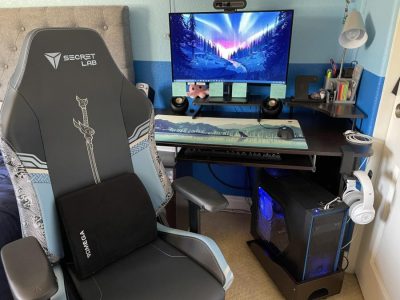
Originally published in The Daily Aztec by Eugènie Budnik
Society has painted a picture of the gamer archetype as white men, often with a penchant for junk food and energy drinks. This stereotype is pushed further by characters such as Jenkins from “South Park” or Philip J. Fry from “Futurama.”
However, these portrayals leave out a large portion of the gaming community who are not white men. Forbes Magazine reports 45% of gamers around the world identify as female, and this number is on the rise.
This Women’s History Month, three female gamers at San Diego State share their love for the hobby as well as their experiences within the gaming community.
Alyssa Garcia is a computer science third year who hopes to go into game development post-graduation.
Garcia is also the co-president of Aztec Gaming Lab, a student-run organization on campus that develops and produces a video game each semester.
“In middle school, when ‘Minecraft’ came out a lot of the friends in my class that were playing were guys. I didn’t know any girls that were playing ‘Minecraft’ at the time,” Garcia said.
Garcia plays a variety of games, but says she appreciates immersive storytelling and simulator games.
When playing online co-op games such as “Valorant,” Garcia has faced sexist remarks from fellow players.
“I have even gotten stuff like ‘oh, go back to the kitchen.’ Someone said that to me one day, and I was like ‘are you kidding me?’ We’re in 2022, this is unnecessary,” Garcia said.
Through Aztec Game Lab and by encouraging her younger sisters into the world of gaming, Garcia hopes to inspire the next generation of female gamers.
“It’s something that everyone can do and it’s something that unites us. I feel like as human beings, video games shouldn’t solely be a male thing. Everyone can agree that video games are fun, and so we should all just enjoy it together,” Garcia said.
Emely Cristales-Linares is a first year psychology major, and a captain of one of Aztec Gaming Club’s “Valorant” teams.
“I loved the interactive worlds you can do, and that is what brought me into the gaming life. Later on, I got my own PC and started getting into more games,” Cristales-Linares said.
Cristales-Linares talked about the oversexualization of female gamers amidst the increasing popularity of self-declared “gamer girl” YouTubers such as Belle Delphine, whose popularity spiked after she began posting photos and videos making suggestive faces often found within erotic manga.
“It makes me feel really uncomfortable, and I think it’s a conversation that needs to be had,” Cristales-Linares said. “You don’t know who is on the other side of the screen, you don’t know who you are talking to, or their experiences. It is really inappropriate to just sexualize them immediately.”
The way in which female video game characters are often designed or costumed also adds to the uncomfortable feeling Cristales-Linares has.
“I feel like female models in games, they’re always turned to being more sexual and sexy. When like, that shouldn’t be the case because they’re just going to be shooting some alien or robot or something. It is really unnecessary,” Cristales-Linares said.
Within her leadership role in Aztec Gaming, Cristales-Linares has found support from her peers.
“It opens up the conversation of having a woman in power for this gaming team. I really like that,” Cristales-Linares said.
India Wishart is a graphic design transfer student. Wishart became interested in video games after playing with her mom and stepdad.
“My mom played MMOs [massively multiplayer online games], like she played ‘Meridian 59.’ I also played “Civilization” with my dad and uncle,” Wishart said.
Wishart said she holds a more optimistic view of representation of women within the video game industry.
“When I was younger, there were a lot less women developing games and they were sort of an underrepresented target market. Because there was an assumption that boys were more likely to like games, so they would target boys more,” Wishart said. “I think nowadays, people realize that women are a huge part of their market. There’s a lot more women who grew up playing games and are making games now.”

